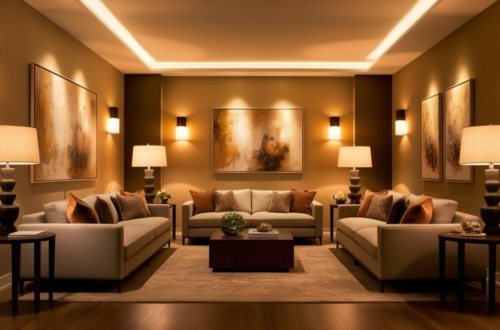
How Can You Make a Small Living Room Look Big?
Creating the illusion of space in a small living room is both an art and a science. If you’ve ever felt like your living room is closing in on you, don’t worry—I’ve been there too. Over the years, I’ve discovered several tricks and tips that can transform even the coziest of spaces into a room that feels open, airy, and inviting. Let me share some of my favorite strategies with you, so you can achieve a bigger-looking living room without knocking down any walls!
1. Opt for a Light and Neutral Color Palette
One of the easiest ways to make a small living room look bigger is by choosing light, neutral colors for your walls, furniture, and décor. Shades like white, beige, soft gray, or pastels can reflect light, instantly brightening the space. Personally, I love using off-white or cream tones, as they create a warm, welcoming vibe while still keeping the room feeling spacious. To add depth, I suggest incorporating subtle pops of color through cushions, artwork, or a stylish rug.

2. Choose Multi-Functional Furniture
When space is at a premium, every piece of furniture needs to work double duty. I highly recommend investing in multi-functional furniture, such as ottomans with hidden storage, foldable coffee tables, or sofas that double as beds. Not only do these pieces save space, but they also help reduce clutter—one of the biggest culprits in making a room feel small.

3. Embrace Mirrors to Reflect Light and Space
If there’s one trick I swear by, it’s using mirrors to create the illusion of a larger room. Placing a large mirror opposite a window can reflect natural light throughout the space, making it feel brighter and bigger. Alternatively, you can create a gallery wall of smaller mirrors for a chic, decorative touch. I suggest experimenting with different shapes and frames to suit your personal style.

4. Maximize Vertical Space
When floor space is limited, the best way to go is up! Utilizing your walls can make a small living room feel larger by drawing the eye upward. I recommend installing tall bookshelves, hanging curtains close to the ceiling, or even adding vertical paneling for a sleek, elongated look. Trust me, this simple change can make a world of difference.

5. Keep the Layout Open and Uncluttered
An open layout is key to making a small living room feel spacious. Arrange your furniture to create clear pathways and avoid overcrowding the room. For instance, instead of a bulky coffee table, I like to use a small side table or a set of nesting tables. Additionally, I always suggest decluttering regularly—keeping only the essentials on display and storing the rest out of sight.
Shebria Solid Wood Frame 2 Nesting Coffee Table

6. Play with Lighting
Lighting can make or break the ambiance of any room, especially a small one. Instead of relying solely on overhead lights, I suggest layering different light sources like floor lamps, table lamps, and wall sconces. Warm, diffused lighting can create a cozy atmosphere, while strategically placed lights can highlight specific areas and make the room feel larger.

7. Use Rugs to Define Spaces
A well-chosen rug can anchor a room and define its boundaries, which is particularly useful in small spaces. I recommend selecting a rug that fits under all your major furniture pieces, as it can make the area feel cohesive and unified. Light-colored or subtly patterned rugs work best to enhance the sense of space.

8. Hang Artwork Thoughtfully
Artwork can elevate any space, but in a small living room, placement is key. I suggest hanging art at eye level and opting for one large statement piece instead of multiple small ones. This creates a focal point without overwhelming the space. Alternatively, a gallery wall with a consistent color theme can also add character without making the room feel cluttered.

9. Bring in Plants for Freshness and Height
Adding greenery to your living room not only brings life to the space but also enhances its overall aesthetic. Tall plants, such as fiddle-leaf figs or snake plants, can draw the eye upward, making the room feel taller. I often place a plant in an unused corner or on a sleek plant stand to maximize visual interest.
Snake Plant and Fiddle Leaf Fig Bush

10. Keep Window Treatments Minimal
Heavy drapes can make a small room feel even smaller. Instead, I suggest going for sheer curtains or blinds that let in plenty of natural light. When hanging curtains, mount the rod closer to the ceiling and let the fabric touch the floor—this creates an illusion of taller windows and higher ceilings.
Tabitha Airy Gauze White Sheer Grommet

11. Choose Furniture with Exposed Legs
Bulky, solid furniture can weigh down a small living room. That’s why I recommend choosing pieces with exposed legs, like mid-century modern sofas or armchairs. These designs create a sense of openness by allowing light and air to flow underneath.

12. Maintain a Cohesive Color Scheme
Finally, sticking to a cohesive color scheme throughout the room can make it feel larger and more harmonious. Whether it’s shades of gray and blue or beige and white, keeping your palette consistent helps avoid visual clutter. I suggest adding subtle textures like woven baskets or knitted throws to keep the look interesting without overwhelming the space.

Final Thoughts
Making a small living room look big doesn’t require a complete renovation. With thoughtful choices in color, furniture, and layout, you can transform your space into one that feels airy, open, and stylish. I’ve used these tips in my own spaces and can attest to their effectiveness. So, take a step back, evaluate your room, and start implementing these ideas one by one. You’ll be amazed at how much bigger your small living room can feel!
For more design inspiration, check out my other article: Tips for Choosing the Best Living Room Couch








11 Comments
Pingback:
Kennedi Mcdaniel
There is definately a lot to find out about this subject. I like all the points you made
Isabelle U. C. Fernandez
Looking forward to your next post. Keep up the good work!
izmir haberleri
Great information shared.. really enjoyed reading this post thank you author for sharing this post .. appreciated
seo hizmeti
I just like the helpful information you provide in your articles
Ankara Haber
You’re so awesome! I don’t believe I have read a single thing like that before. So great to find someone with some original thoughts on this topic. Really.. thank you for starting this up. This website is something that is needed on the internet, someone with a little originality!
İstanbul Haber
Hi there to all, for the reason that I am genuinely keen of reading this website’s post to be updated on a regular basis. It carries pleasant stuff.
Yalova Son Dakika Haberleri
Very well presented. Every quote was awesome and thanks for sharing the content. Keep sharing and keep motivating others.
Kütahya Son Dakika
This was beautiful Admin. Thank you for your reflections.
https://elazigda-magazin.com.tr/
I like the efforts you have put in this, regards for all the great content.
Antalya Magazin
Nice post. I learn something totally new and challenging on websites